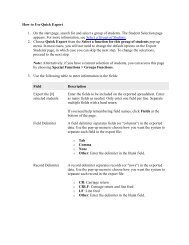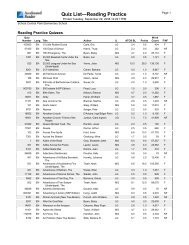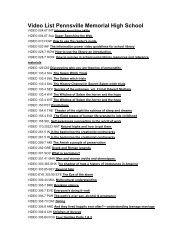PSD BOE Grading Policy 2010 (pdf) - Pennsville School District
PSD BOE Grading Policy 2010 (pdf) - Pennsville School District
PSD BOE Grading Policy 2010 (pdf) - Pennsville School District
Create successful ePaper yourself
Turn your PDF publications into a flip-book with our unique Google optimized e-Paper software.
EVALUATION OF INDIVIDUAL REGULATION: 6147.1R<br />
STUDENT PERFORMANCE<br />
P. Related Arts or Project based Courses:<br />
1. Middle <strong>School</strong><br />
In the middle school, the teacher should evaluate student progress in terms of individual<br />
growth and encourage student self-evaluation through individual and group critiques. Emphasis<br />
should be focused on the creative process rather than the final product. The teacher should use<br />
rubric based assessments for student work. Related Arts educators recognize that some skills<br />
may be measured by testing or objective product evaluation. Effective teachers also make<br />
evaluative judgments based on expressive measures. The grading criteria established for middle<br />
school related arts classes must recognize both of these elements.<br />
Objective scores and documentation of the teacher‟s professional judgment will be<br />
maintained to determine the student‟s daily/weekly grades. In formulating grades the relative<br />
weight of these components may vary from unit to unit. Teachers should use rubrics showing<br />
how their subjective assessments translate into grades. When reporting progress, teachers must<br />
be sure that the system is easily understood by the students and the parents.<br />
2. High <strong>School</strong><br />
In a high school related arts course, evaluation of the student‟s total experience requires<br />
consideration of the individual‟s aesthetic growth, understanding of art culture and heritage, and<br />
development of skills, as well as the quality of creative work. Teacher evaluation must include<br />
evidence of artistic growth. Since innovation, imaginative response, and expression are highly<br />
valued in the arts, evaluation must be based on the student‟s individual growth. The teacher‟s<br />
professional judgment is extremely important in evaluating that growth.<br />
In both objective and expressive evaluation, in addition to rubrics the teacher may use a<br />
variety of formal and informal assessment tools (observations, checklists, discussion, portfolios,<br />
demonstrations, exhibitions, sketch-books, self-evaluation, written and oral reports and tests, and<br />
individual and group critiques). For grading purposes the relative weight of the objective and<br />
subjective components will vary depending on the criteria established for the individual unit or<br />
project. The student should have a good understanding of the criteria being used for each<br />
segment of the curriculum.<br />
Q. Physical Education Courses:<br />
1. Middle <strong>School</strong>/High <strong>School</strong><br />
For Physical Education courses at the middle school and high school, the teacher should evaluate<br />
student progress in terms of individual growth and mastery of the standards which the State of NJ<br />
has adopted for Physical Education. In order for students to show growth and ultimately achieve<br />
the standards, participation in all activities is essential. Due to the physical nature of the activities<br />
6







